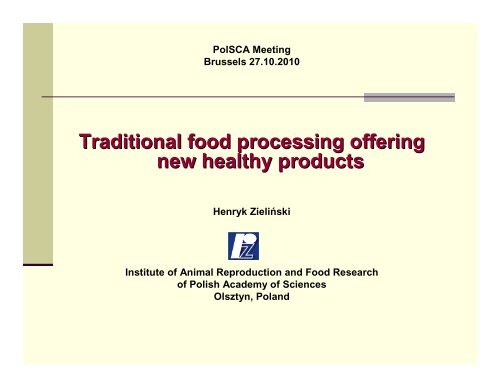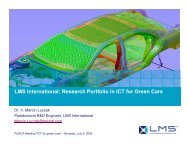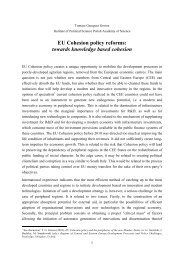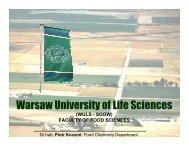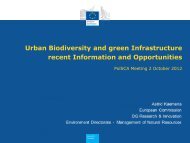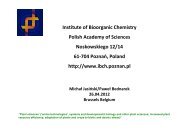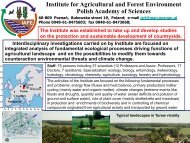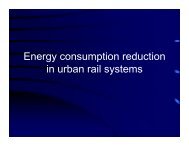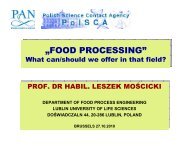Dr Henryk Zielinski - PolSCA
Dr Henryk Zielinski - PolSCA
Dr Henryk Zielinski - PolSCA
You also want an ePaper? Increase the reach of your titles
YUMPU automatically turns print PDFs into web optimized ePapers that Google loves.
<strong>PolSCA</strong> Meeting<br />
Brussels 27.10.2010<br />
Traditional food processing offering<br />
new healthy products<br />
<strong>Henryk</strong> Zieliński<br />
Institute of Animal Reproduction and Food Research<br />
of Polish Academy of Sciences<br />
Olsztyn, Poland
Institute of Animal Reproduction and Food<br />
Research of Polish Academy of Sciences,<br />
Olsztyn,<br />
Poland
Institute of Animal Reproduction and Food<br />
Research of Polish Academy of Sciences<br />
Division of Food Science<br />
Centre of Excellence<br />
CENEXFOOD<br />
Division of Reproductive Endocrinology<br />
and Pathopysiology<br />
Centre of Excellence<br />
BIOANIREP<br />
• Department of Biosensors<br />
• Department of Food Immunology and Microbiology<br />
• Department of Chemical and Physical Properties of Food<br />
• Department of Biological Function of Food<br />
• Department of Chemistry and Biodynamics of Food
Chemistry and biodynamics of food<br />
• Qualitative and quantitative changes in biologically-active compounds of plant origin and the<br />
total antioxidative capacity of food in technological processes<br />
• The potential activity of biologically-active compounds of plant origin in human prophylaxis<br />
and modelling rheological food qualities.<br />
• Studies on animals and in non-clinical medical trials on volunteers that address the<br />
bioavailability of biologically-active compounds in respect of changes proceeding in the food<br />
matrix upon technological processing.
Chemistry and biodynamics of food<br />
Achievements<br />
Determining the antioxidative potential of basic cereals (buckwheat > barley > oats > rye ><br />
wheat);<br />
Analysing absorption of selected flavonoids and postulating a sequence of their conjugation;<br />
Proving the beneficial effect of the food matrix, especially on absorption processes of<br />
flavonoids, which are poorly soluble in the alimentary tract;<br />
Patent No P. 325981: ”Method for obtaining starch food preparation with elevated resistance to<br />
amylolytic enzymes”;<br />
Patents (No P 386253 and No P 386254): “Gluten-free baking formula” and “Gluten-free<br />
formula”.
2.2 Fork to Farm: Food, Health and Well Being<br />
<br />
<br />
Consumer, societal, industrial<br />
and health aspects of food and<br />
feed<br />
Nutrition, diet related diseases<br />
and disorders<br />
Food Processing<br />
<br />
<br />
Improved Quality and Safety of<br />
food, beverage and feed<br />
Total Food Chain concept
Food processing<br />
Activities in Poland - aims<br />
Extending the national and world market with a new healthy products of<br />
high nutritional value.<br />
Increasing the competiveness of the Polish food industry.<br />
Stimulating progress in the Polish agriculture through selection of raw<br />
materials and optimization of production process.<br />
Improving the health status of the Polish population with the use of food<br />
products for prophylactics against diet-related diseases (obesity,<br />
neoplasmic disease, CVD, allergy and diabetes).<br />
Introducing innovative, waste-free and energy-saving food production<br />
technologies to minimise environmental risks by food processing plants.
Food processing<br />
Activities in Poland - scopes<br />
Research on the selection of a new plant cultivars and animal spieces.<br />
Elaboration and inplementation of the new technology for the<br />
production of functional foods.<br />
Research on safety, composition and nutritional value of the new food<br />
products as component of balanced diet.<br />
Epidemiological and clinical surveys on the health promoting food<br />
products.<br />
Consumer surveys and local and international promotion strategy for<br />
the new food products.
Advanced food processing<br />
High pressure processing<br />
inactivation of bacteria and enzymes<br />
Pulsed electric field processing<br />
microbial inactivation<br />
Microwave processing<br />
drying, cooking, pasteurization,<br />
defreezing<br />
Microwave processing under low pressure<br />
Dehydratation<br />
Processing by ionising radiation of high energy<br />
„Irradiated for your safety”<br />
Sprout inhibition, ripeaning delay, insect<br />
desinfestation<br />
Suppression of pathogen microorganisms<br />
Can be used for packaged food
Traditional food processing<br />
Germination<br />
Fermentation<br />
Sourdough<br />
fermentation<br />
Thermal processing<br />
Roasting<br />
Baking<br />
Toasting<br />
Cooking
Consumer needs<br />
Food is expected to be:<br />
Safe<br />
Cheap<br />
Whole year available<br />
Easy to prepare<br />
Providing high energy load<br />
Pro-health<br />
Diverse<br />
Enjoyable<br />
Of high nutritional value
REGULATION (EC) No 1924/2006 OF THE EUROPEAN PARLAMENT<br />
AND OF THE COUNCIL of 20 December 2006<br />
on nutrition and health claims made on foods<br />
(in force from 1st July, 2007)<br />
Article 4<br />
Conditions for the use of nutrition and health claims<br />
1. By 19 January 2009, the Commission shall, in accordance<br />
with the procedure referred to in Article 25(2), establish specific<br />
nutrient profiles, including exemptions, which food or certain<br />
categories of food must comply with in order to bear nutrition<br />
or health claims and the conditions for the use of nutrition or<br />
health claims for foods or categories of foods with respect to<br />
the nutrient profiles.<br />
Article 6<br />
Scientific substantiation for claims<br />
1. Nutrition and health claims shall be based on and substantiated<br />
by generally accepted scientific evidence.
Back to tradition: germination and fermentation –<br />
production of food with increased antioxidative power<br />
Sprouting is a simple way to obtain a product with highly enhanced<br />
antioxidative capacity coming most likely from rapidly biosynthesised<br />
low molecular antioxidants.<br />
Fermentation is an easy and effective process to obtain products with<br />
higher antioxidative capacity and could be recommended for application<br />
in functional foods preparation/industry to provide consumers with a<br />
product with added value.
Traditional food processing:<br />
focus on rye-based<br />
food products<br />
rye<br />
Antioxidants content and properties as quality indices of rye cultivars. Food Chem., 2007, 104, 980-<br />
988.<br />
The antioxidant contents and antioxidative properties of traditional rye breads. J. Agric. Food Chem.,<br />
2007, 55, 734-740.<br />
Antioxidant properties and sensory quality of traditional rye bread as affected by the incorporation of<br />
flour with different extraction rates in the formulation. Eur. Food Res. Technol., 2008, 226, 671-680.<br />
Effect of baking on the formation of MRPs contributing to the overall antioxidant activity of<br />
rye bread. J. Cereal Sci., 2008, 48, 123-132.<br />
Protein profile and sensorial properties of rye breads. Eur. Food Res. Technol., 2009, 229 (6), 875-<br />
886.<br />
Rye flour extraction rate affects Maillard reaction development, antioxidant activity, and acrylamide<br />
formation in bread crisps. Cereal Chemistry, 2010, 87 (2), 131-136.<br />
Evaluation of antioxidant capacity and formation of processing contaminants during rye bread<br />
making. Journal of Food and Nutrition Research, 2010, 49 (3), 149–159.
Traditional food processing:<br />
focus on spelt-based<br />
food products<br />
Bioactive compounds in spelt bread. Eur. Food Res. Technol.,2008, 226 (3), 537-544.<br />
Antioxidant properties of spelt bread. Pol. J. Food Nutr. Sci., 2008, 58, 217-222.<br />
spelt
Traditional food processing:<br />
focus on buckwheat-based based food products<br />
Poland<br />
Germany<br />
Italy<br />
Austria<br />
Bialorus<br />
Ukraine<br />
Sweden<br />
Russia<br />
Finland<br />
Norway<br />
×<br />
•<br />
°<br />
Regions of cultivation and research on buckwheat<br />
Regions of temporary buckwheat cultivation<br />
Regions of buckwheat cultivation in the past
Use of buckwheat<br />
USA<br />
Japan<br />
Central-Eastern Europe<br />
Processed flour<br />
Whole grains<br />
Milled groats<br />
Dehulled seeds<br />
(groat)<br />
Bread<br />
Pasta products<br />
Breakfast cereals<br />
Soba noodles<br />
Extruded cereals<br />
Snack products<br />
Roasted groat<br />
(kasha)
Biologically active compounds of buckwheat<br />
with beneficial action on consumer’s s organism<br />
Proteins<br />
Phytosterols<br />
Cholesterollowering<br />
effect<br />
Phytosterols<br />
Improving the<br />
immunological status<br />
Fagopirins<br />
Utilized in the<br />
treatment of type II<br />
diabetes<br />
Proteins<br />
extract<br />
Thiamin-binding<br />
proteins<br />
Utilized for people<br />
who suffer from the<br />
lack of thiamin and<br />
can not store<br />
thiamin<br />
Flavonoids<br />
Beneficial in treatment<br />
of the hypertension,<br />
obesity,<br />
alcoholism,constipation
Phytochemicals attracting<br />
attention due to their<br />
potential health beneficial action<br />
• Carotenoids Fruit and vegetables<br />
• Lycopene Tomato<br />
• Glucosinolates Brassica<br />
• Catechins Tea<br />
• Flavonoids Fruit and vegetables<br />
• Resveratrol Wine<br />
• Anthocyanins Berries<br />
• Rutin Buckwheat<br />
• C-glucoflavones
Potential<br />
health beneficial action of buckwheat flavonoids<br />
Rutin - quercetin-3-rutinoside<br />
• anti-inflammatory and vasoactive properties<br />
• capability to diminish capillary permeability<br />
• reduce the risk of arteriosclerosis<br />
• reducing coronary heart disease,<br />
• diminishing of platelet aggregation<br />
• inhibiting low-density lipoprotein (LDL) peroxidation<br />
• protective effects against ethanol-induced gastric lesions<br />
• against DNA damage<br />
• protective agent against carcinogenesis<br />
• the most potent natural inhibitors of AGEs formation<br />
• hypocholesterolemic effect in humans after the intake of buckwheat products.<br />
Orientin<br />
Homoorientin<br />
Izovitexin<br />
Vitexin<br />
• hypotensive properties<br />
• anti-inflammatory<br />
• antispasmodic<br />
• antimicrobial<br />
• radioprotective effects<br />
• anti-glycation
Functional food<br />
Any food claimed to exhibit health-promoting or disease-preventing action on the<br />
consumer beyond the basic function of nutrient supply. It includes foods fortified<br />
with health-promoting compounds. Food with live bacteria cultures is also<br />
considered to be functional food with probiotic benefits.<br />
The strategy for functional food development<br />
Identification<br />
Food Function<br />
Mechanism<br />
Functional effect<br />
Functional food as a driving force:<br />
constant search for new bioactive food<br />
ingredients<br />
demand for new sources of bioactive<br />
compounds<br />
demand for natural food<br />
Hypothesis-driven human nutrition studies<br />
Enhanced function Claim Disease risk reduction<br />
G.R. Gibson and M.Williams (Eds), CRC Press 2000.
What do we know?<br />
Scientific evidences<br />
Rutin metabolites: Novel inhibitors of nonoxidative advanced glycation end products.<br />
Free Radical Biology & Medicine 48 (2010) 656-663<br />
Inhibition of advanced glycation end product formation on collagen by rutin and its<br />
metabolites<br />
Journal of Nutritional Biochemistry 17 (2006) 531–540<br />
Protein glycation inhibitory activity of wheat bran feruloyl oligosaccharides<br />
Food Chemistry 112 (2009) 350–353<br />
Buckwheat honey increases serum antioxidant capacity in humans.<br />
J. Agric. Food Chem., 2003, 51, 1500-1505<br />
Advanced glycation endproducts—role in pathology of diabetic complications<br />
Diabetes Research and Clinical Practice 67 (2005) 3–21
Advanced<br />
glycation endproducts<br />
Hyperglycemia as the main risk factor for the development of diabetic complications.<br />
Enhanced formation and accumulation of AGEs have been implicated as a major<br />
pathogenesis process leading to diabetic complications, normal aging, atherosclerosis, and<br />
Alzheimer’s Disease.
Absorption mechanism is recognized<br />
GLYCOSIDES - absorption starts from the colon<br />
limitations – can be substantially degraded by local microflora
Degradation of rutin n in the colon<br />
Pashikanti S., de Alba D.R., Boissonneault G.A., Cervanted-Laurean. Rutin metabolites:<br />
Novel inhibitors of nonoxidative advanced glycation end products. Free Radical Biology &<br />
Medicine 48 (2010) 656-663
Traditional food processing:<br />
focus on buckwheat-based based food products<br />
roasted groat<br />
buckwheat milling products<br />
buckwheat enriched wheat bread<br />
buckwheat enriched ginger cakes<br />
gluten-free bread with buckwheat flour<br />
buckwheat sprouts as a functional additive to food<br />
buckwheat hull tea infusion<br />
fermented buckwheat groat by fungi (Rhizopus oligosporus)<br />
high pressured buckwheat raw and roasted groat (200 MPa)
Buckwheat industry in Poland<br />
Raw buckwheat<br />
Steaming<br />
Roasting<br />
Dehulling<br />
Typical milling products from<br />
unhusked and husked buckwheat<br />
Hulls – waste byproduct<br />
Wholegrain<br />
buckwheat flour<br />
Roasted groat<br />
Milling<br />
Light buckwheat<br />
flour<br />
℘<br />
Aroma<br />
Novel buckwheat flour<br />
from roasted groat<br />
℘<br />
℘<br />
Taste<br />
Colour<br />
New application in bakery
The use of buckwheat flour in breadmaking<br />
Light buckwheat flour<br />
Flour from roasted buckwheat<br />
C o n v e n c io n a l u n its<br />
10<br />
9<br />
8<br />
7<br />
6<br />
5<br />
4<br />
3<br />
2<br />
1<br />
0<br />
30/70%<br />
50/50%<br />
50/50%<br />
30/70%<br />
1 2 3 4 5 6 7<br />
Buckwheat enriched bread<br />
•buckwheat enriched wheat breads with increased<br />
functionality due to the increased antioxidant contents<br />
and antioxidant properties,<br />
•novel buckwheat flour from milled roasted groats may<br />
offer a buckwheat enriched wheat breads with higher<br />
overall sensory quality than dark and white wheat<br />
breads.<br />
(1) white wheat bread<br />
(2, 3) buckwheat flour „BIO” enriched white wheat breads<br />
(4, 5) flour from roasted buckwheat groat enriched white wheat breads
Gluten-free<br />
formula with buckwheat flour
Buckwheat hull tea infusion – possible utilization<br />
of<br />
waste material<br />
Rutin and vitexin were the main flavonoids found in buckwheat hull tea. The buckwheat hull<br />
tea showed lower antioxidant capacity and inhibitory activity against the formation of<br />
fluorescent advanced glycation end products as compared to green tea.
Ginger cakes enriched in rutin<br />
* Cerutin<br />
* Novorutin C<br />
* Rutinacea Complete<br />
* Rutinoscorbin<br />
* Rutovit<br />
* Scorborutin 1 tablet: Rutin 25 mg, L-askorbic acid 100 mg<br />
50 g of produckt should correspond to 1 tablet of<br />
drug<br />
Mass: 50 g<br />
6 pieces<br />
rye flour<br />
buckwheat flour<br />
buckwheat honey<br />
spices
Buckwheat sprouts – a new vegetable<br />
Sprouted in the darkness<br />
Pickled sprouts<br />
Juice from sprouts<br />
<strong>Dr</strong>y sprouts as tea ingredient<br />
Sprouted in the light<br />
15<br />
12<br />
9<br />
6<br />
[µM /g d.m .]<br />
Rapid biosynthesis:<br />
• flavonoids<br />
• ascorbic acid<br />
• α-tocopherol.<br />
10 day<br />
8 day<br />
3<br />
6 day<br />
4 day<br />
seeds<br />
orientin<br />
rutin<br />
isovitexin<br />
isoorientin<br />
vitexin<br />
0
Fermented buckwheat groat by fungi<br />
(Rhizopus<br />
oligosporus)<br />
Fermentation<br />
Soaking<br />
Cooking<br />
Cooling<br />
Dehulling<br />
Fermentation (20-30 h)<br />
Benefits of fermentation<br />
• Increased total proteins in product,<br />
• Increased protein digestibility,<br />
• Elimination of some allergic proteins (24, 19 and 16kDa)<br />
• Decreased phytic acid content,<br />
• Higher biosynthesis of vitamin B group.
Buckwheat food factory of the future – waste-free<br />
and<br />
energy saving<br />
selection of buckwheat cultivar<br />
selection of high antioxidant<br />
material from aerial parts
Our research and experience<br />
buckwheat<br />
Low Molecular Weight Antioxidants and Other Biologically Active Components of Buckwheat Seeds.<br />
EJPSB, 2009, 3 (SI 1).<br />
Antioxidants in thermally treated buckwheat groats. Mol. Nutr. Food Res., 2006, 50, 824-832.<br />
Comparison of spectrophotometric and electrochemical methods for the evaluation of antioxidant<br />
capacity of buckwheat products after hydrothermal treatment. J. Agric. Food Chem., 2007, 55 (15),<br />
6124-6131.<br />
Changes in protein quality and antioxidant properties of buckwheat seeds and groats induced by<br />
roasting. J Agric Food Chem., 2009, 57, 4771-4776.<br />
Antioxidative and Anti-glycation Activity of Bitter Buckwheat Tea. EJPSB, 2009, 3 (SI 1).<br />
Determination of the antioxidant activity of rutin and its contribution to the antioxidant capacity of<br />
diversified buckwheat origin material by updated analytical strategies. Pol. J. Food Nutr. Sci., 2010,<br />
60, 315-321.<br />
Antioxidant activity of flavone C-glucosides determined by updated analytical strategies. Food<br />
Chemistry, 2011, 124, 672-678.
Thank you for your attention


